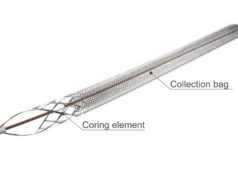
Data from the randomised controlled ATTRACT trial revealed that the addition of catheter-based intervention to standard-of-care anticoagulation failed to significantly decrease the occurrence of post-thrombotic syndrome in patients who received this treatment strategy when compared to its occurence in patients who received anticoagulation alone. While there is disappointment at the headline findings of this landmark trial, experts have called the data both illuminating and hypothesis-generating.
The National Institutes of Health (NIH)-sponsored, phase III, multicentre ATTRACT (Acute venous thrombosis: thrombus removal with adjunctive catheter-directed thrombolysis) trial set out to determine if the use of pharmacomechanical catheter-directed thrombolysis added to standard care for above-the-knee proximal deep vein thrombosis prevents the post-thrombotic syndrome from developing over two years.
The primary outcome measure was the cumulative occurence of post-thrombotic syndrome between six and 24 months after randomisation, as measured by the Villalta scale. Secondary outcomes include safety, general and venous disease-specific quality of life, relief of early pain and swelling, post-thrombotic syndrome severity and cost-effectiveness.
ATTRACT data on the long-term effects of pharmacomechanical catheter-directed thrombolysis showed that 46.7% of the group that received interventional therapy went on to develop post-thrombotic syndrome, whilst 48.2% of those who received anticoagulation alone went on to develop post-thrombotic syndrome (p=0.56).
“Whilst ATTRACT results show no difference in the development of post-thrombotic syndrome in the two groups, there is a suggestion that getting the clot out is associated with a reduced severity of post-thrombotic syndrome,” Suresh Vedantham, the national principal investigator of the trial, told delegates at the Society of Interventional Radiology’s annual scientific meeting in Washington, DC, USA, where he presented the results for the first time today. Vedantham is professor of Radiology and Surgery, Mallinckrodt Institute of Radiology, Washington University School of Medicine in St Louis, USA.
Short-term data captured from the trial showed that the effects of pharmacomechanical catheter-directed lysis resulted in more major bleeds in the interventional arm (1.7%) than in the in the control arm, (0.3%; p=0.049). There were also significantly more instances of any bleeding (4.5%) in the interventional arm vs. 1.7% in the control arm (p=0.049). There were no fatal or intracranial bleeds in either arm of the trial indicating that few patients will be harmed as a result of thrombolytic therapy.
“Pharmacomechanical catheter-directed thrombolysis does not prevent post-thrombotic syndrome, and does increase bleeding. The ATTRACT data suggest that most deep vein thrombosis patients can avoid an [adjunctive] unhelpful procedure. Data also suggest that we need a better understanding of the pathogenesis of post-thrombotic syndrome. However, pharmacomechanical catheter-directed thrombolysis reduces early deep vein thrombosis symptoms and post-thrombotic syndrome severity. [As such] The open vein hypothesis is likely relevant to post-thrombotic syndrome progression and there is a suggestion that targeting this therapy to patients with iliofemoral deep vein thrombosis based on the high risk of post-thrombotic syndrome [might be beneficial],” Vedantham added.
The results suggest that pharmacomechanical catheter-directed thrombolysis should not be routinely used to prevent post-thrombotic syndrome in patients with symptomatic proximal deep vein thrombosis above the popliteal vein as there is no added benefit to exposing them to the risks and costs of additional catheter-based thrombolysis. The current standard therapy for patients with acute proximal deep vein thrombosis consists of anticoagulation and compression bandages.
However, data from subgroups and secondary analyses suggest that catheter-directed thrombolysis may have a benefit in patients who have acute iliofemoral deep vein thrombosis. The data also showed a trend towards greater treatment effect for catheter-based interventions with patients who present with more severe symptoms. However, triallists emphasise that ATTRACT was not statistically powered to draw definitive conclusions from these secondary analyses and outcomes and that the treatment effect seen in these should be seen as trends only and springboards for future research.
The triallists enrolled approximately 692 patients with acute proximal deep vein thrombosis involving the femoral, common femoral, and/or iliac vein into the ATTRACT study at 56 centres. They randomised 337 catheter-directed thrombolysis and 355 to anticoagulation alone.
The devices used in the trial to achieve pharmacomechanical catheter-directed thrombolysis were the AngioJet thrombectomy system (Boston Scientific); the Trellis-8 Peripheral Infusion System (Medtronic. This device is no longer on the market); or catheter-directed rt-PA infusion for up to 24 hours via a multisidehole infusion catheter.
“The limitations from this study are that there were losses to follow-up and that it was a medium-sized study. It was also not designed to evaluate specific methods of pharmacomechanical catheter-directed lysis,” Vedantham said.
An expert panel convened after the presentation pointed to the fact that this is a complex dataset because iliofemoral deep vein thrombosis has a different prognosis and natural history from femoropopliteal clot. Yet, these two different disease entities were grouped together in this trial for various valid reasons and because it was reasonable to evaluate if the open vein hypothesis might apply to both.
Mahmood Razavi, director, Center for Clinical Trials and Research, Heart and Vascular Center, St Joseph Hospital, Orange, California, USA, who is on the steering committee of the trial told Interventional News: “First, Suresh Vedantham deserves huge credit for undertaking the monumental task of running this trial. His contribution to the field of deep vein thrombosis research is immense and must be acknowledged. Second, interventional radiologists have long existed in a ‘pre-facts’ world and this trial provides the first rigorous dataset for catheter-directed lysis in deep vein thrombosis. When spinning the results of this trial, the purists will emphasise the statistical analysis and focus on the fact that the trial failed to meet its primary endpoint. However, pragmatists looking at the same data might interpret it differently and focus on the direction of treatment effect seen for catheter-based interventions in specific subgroups. For those of us who have been performing venous interventions for a long time, these data confirm what we have observed in clinical practice. From the practical standpoint, the data are encouraging for those patients with acute iliofemoral deep vein thrombosis. Also, if you look at clinically relevant measures such as a moderate to severe Villalta score and Venous Severity score, there is a signal there. However, it is important that these are clearly understood to be signals and tested further in an appropriate manner. There are very good clues from the ATTRACT data to further identify patients who would benefit from catheter-based treatments. We see from the data that there is a strong likelihood that certain groups of patients are helped more than others with additional catheter-based thrombolysis. In my view, the ATTRACT data are fantastically illuminating and hypothesis-generating. This is just the beginning of our research and activities in deep vein thrombosis.”
The panel of multidisciplinary experts including Michael Jaff (Massachussetts, USA) Timothy Murphy (Rhode Island, USA), Anthony Comerota (Toldeo, USA), Clive Kearon (Hamilton, Canada) and Susan Kahn (Montreal, Canada) convened immediately after the presentation, discussed the implication and impact of the findings. Some members opined that these results would see venous thromboembolism guidelines hardening to restrict the use of catheter-directed thrombolysis in deep vein thrombosis patients. Others felt the study provided a starting point in the identification of patient subgroups that would benefit from the treatment.
Razavi also called attention to the parallels between the ATTRACT trial results and trials in the world of stroke interventions. “The initial NIH-sponsored IMS- III (Interventional management of stroke III) trial showed no benefit for endovascular therapy after the use of intravenous thrombolysis over intravenous thrombolysis alone in the treatment of acute ischaemic stroke. This was due to older devices being used and for various other reasons. However, after these results came out, industry, propelled by the investigators’ belief that getting the clot out helps patients, took it upon themselves to carry out the definitive studies in the appropriate patients and we then saw a host of high quality trials (such as MR CLEAN, ESCAPE, EXTEND IA and SWIFT PRIME) that clearly demonstrated the benefit of endovascular treatments for large vessel occlusions in acute ischaemic stroke. Similarly, we are looking forward to ATTRACT being the start of the next phase of deep vein thrombosis research,” he said.









